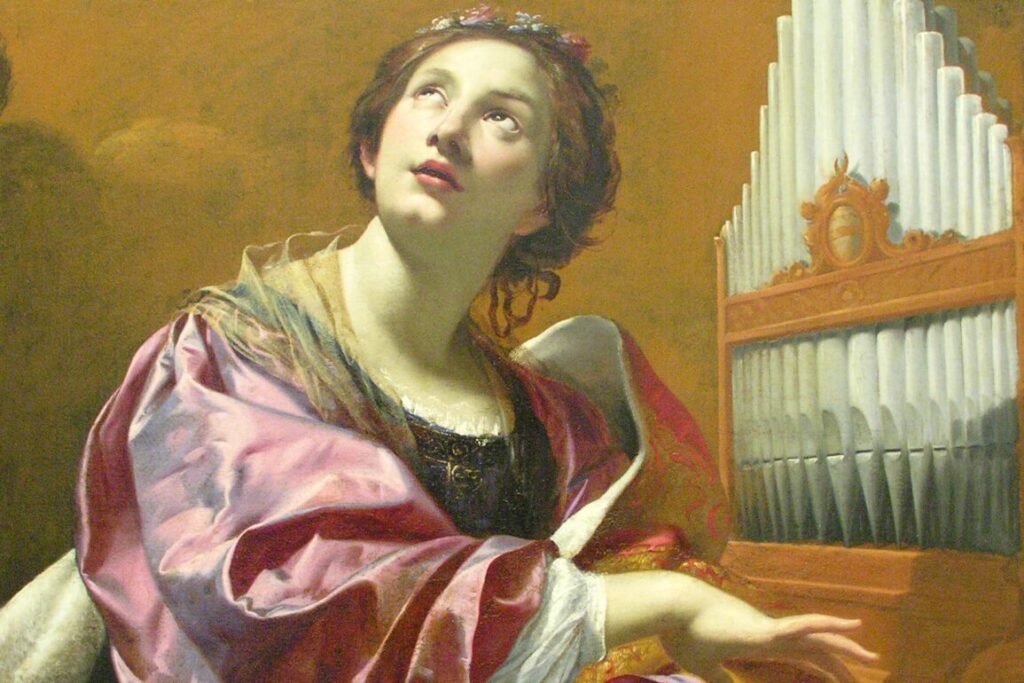St. Cecilia, November 22
Virgin and martyr

Tradition has it that Cecilia, a young Roman noblewoman, was martyred in approximately the year 230 during the reign of Alexander Severus and the papacy of Urban I. Her cult is ancient: in fact, the title of the homonymous Basilica in Trastevere is older than the Edict of Constantine (313) and the feast in her memory was celebrated as early as the year 545.
The power of love
To learn about her martyrdom, you can read the Passio Sanctae Caeciliae, a text that has more legendary-literary connotations than historical ones. According to the text La Passio, Cecilia married the patrician Valerian for convenience, to whom she tells on their wedding night that she has converted to Christianity and that she has made a vow of perpetual virginity.
Valerian on his own agrees to receive catechism and baptism from Pope Urban I. Later his brother Tiburcio joins him, also embracing the Christian faith. Both brothers were arrested by order of the prefect Turcio Almachio and after being tortured were beheaded along with Massimo, the officer who had taken them to prison and who, on the way, had also converted.
Faith that conquers death
Almachio then decides to kill Cecilia as well. Not an easy action, considering the great popularity that the young Christian enjoyed. He feared repercussions from a public execution, so he decides to subject her to a summary trial and then orders her to be locked up in her own house, locking her in a cauldron at very high temperature, staging a death by asphyxiation. After more than 24 hours, the guards miraculously find her alive, enveloped in a heavenly dew. Almachio then attacks, ordering the decapitation, but the executioner fails to cut off her head, after trying hard three times. Cecilia dies after three days of agony, donates all her possessions to the poor, her house to the Church, and although she cannot speak, she continues to profess her faith in the one and triune God, with the fingers of her hands, which is how she was sculpted by Maderno in the famous statue kept under the central altar of the Basilica that bears her name.
The Gospel in the heart
According to the Golden Legend, the medieval collection of hagiographic biographies composed and written in Latin by the Dominican Jacobus de Varagine, in which there are several narrative paragraphs of the Passio, it is said that it was Pope Urban I, with the help of some deacons, who buried the body of the young martyr in the catacombs of San Calixto, in a place of honor near the Crypt of the Popes. Then, in 821, Pope Paschal I, a great devotee of the Saint, invoked “the virgin Cecilia who always carried the Gospel of Christ on her chest”, transferred the relics to the crypt of the Basilica of Santa Cecilia in Trastevere, which was built in her honour. On the eve of the Jubilee of 1600, during the restoration work of the Basilica ordered by Cardinal Paolo Emilio Sfrondati, the sarcophagus containing the body of the young Saint was found, which was in a perfect state of preservation, wrapped in a silk and gold dress.
Music and iconography
What is the relationship between Saint Cecilia and music? At the end of the Middle Ages, an explicit and documented link was found between the Saint and music. In a piece of music from the Passio, according to some, and in the antiphon of the entrance to the Mass on her feast day, according to others, the lyrics of the piece of music read: “… while the organs were playing, she sang in her heart only to the Lord.” An erroneous interpretation of the text allowed the iconography of the Saint to spread from the middle of the 14th century onwards in various parts of Europe, enriched with musical elements.
A work of art that represents this union of Saint Cecilia with music is Raphael’s work entitled: The Ecstasy of Saint Cecilia, which he made for the Church of San Juan al Monte, in Bologna, representing the saint carrying a portable organ in one hand and various musical instruments at her feet. This work seals the relationship of the Roman martyr with music, which was already invoked and celebrated as the protector of musicians and singers. The Academy of Music, founded in Rome in 1584, bears her name.
Related

Reflection by Bishop Enrique Díaz: Alleluia, alleluia
Enrique Díaz
20 April, 2025
5 min

Christ is Risen! Alleluia! Commentary by Fr. Jorge Miró
Jorge Miró
20 April, 2025
3 min

Easter: Mystery of Freedom
Carlos J. Gallardo
20 April, 2025
5 min

“Being Catholic in Tanzania is a source of pride”
Fundación CARF
16 April, 2025
6 min
 (EN)
(EN)
 (ES)
(ES)
 (IT)
(IT)

